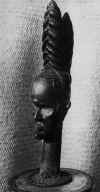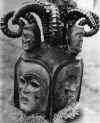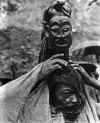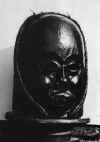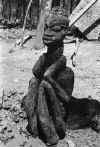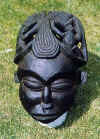Art forms
24
Plate
10
A Challenge mask.
Bangwa
lies at the watershed of two important culture areas – of the Bamileke
the savannah on the one hand, and of the Ekoi
Cross
River
group of the
From the forest, particularly from their nearest western neighbours the Banyang, the Bangwa have acquired a number of secret societies, with their associated masks. The Cross River style is evident in the skin-covered, horned masks of the Challenge (Plate 10) and Royal societies. It is also apparent in the crude fetishes associated with anti-witchcraft cults which have been sweeping through Bangwa from these areas over the past generation. Bangwa witchcraft beliefs, associated with shape are closely akin to forest beliefs. The latest importation from the west has been a series of societies or jujus the most typical of which is the Leopard society (see p. 107) which can
25be
traced as far as Calabar in
A style verging more on the Bamileke style is evident in the ancestor figures, the mother and child figures and the kungang anti-witchcraft fetishes. These are described in detail on pp. 127 ff. Carving associated directly with chiefship – royal paraphernalia such as stools, trumpets, house decoration – can be found in more or less the same style from Fontem across to Dschang, Bafoussam, Bandjoun and Fumban. The regional variations become clear only after close inspection. Thus the work of a Bangwa sculptor which is illustrated in Col. pls 8 and 9 and Fig. 3 is clearly Bamileke in style, and yet the artist has been able to give it his own individuality. The diversity of form and theme throughout Bangwa art, however, makes the definition of an exclusive Bangwa style difficult.
The
precipitous mountains have not prevented an infiltration of ideas and
institutions from the forests to the grasslands. The Bangwa entered this
inhospitable region precisely in order to form a commercial bridge between
the oil forest lands and the populous slave entrepôts of the Bamileke
plateau. As in trade so in art; the Bangwa form a cultural link between
these disparate peoples. Expressionistic influences, alongside witchcraft
beliefs, entered the Bamileke area, mediated by the Bangwa artist. Many of
the styles of imported associations remain distinctive of their place of
origin: this is particularly true of the Challenge masks. Yet Cross
River
influences are found in the chiefly statues: the chief’s head on the
trumpet illustrated in Plate 11 has cicatrisations usually associated with
the forest peoples; the figures of the kungang
society have Bamileke-type facial characteristics with
The
problem of the origins of art objects is not confined to specimens in
museums in
26
Figure
3
Ancestor figure
Plate
11
Plate
12
27
North-eastern savannah. Many ornaments worn by the Bangwa today were bought years ago in Bamileke markets. Cire-perdue objects (pipes and bangles) derive from as far afield as Fumban. Elaborate pottery is not made in Bangwa today; the pots occasionally made by the women now are of much simpler design than the beautiful old eating bowls used ceremonially at special feasts. There are many examples of clay pipes (Plate 13) which are said to have been made locally but which are no longer made today. There are no present bead-workers; yet the Bangwa claim the elaborate calabashes and beaded fly whisk handles as their own work (Fig. 6). There is still doubt about all these objects. However, about most carved masks and figures there can be none. Specific details are known about each figure, sometimes even the name of the carver. Masks in the same style as the old ones are still being made.
The types of art objects to be discussed in this book are primarily masks and figures. The function, form and value of these objects vary. Bangwa art can be utilitarian, or it can be religious or sometimes purely aesthetic. The imposing beauty of a portrait statue is a positive attribute of its supernatural sanctions.
28
Clay pipes of the type often represented in Royal portrait statues
Figure
4
Ancestor figure
The
expressionist strength of a secret society mask reflects the privileges
and powers of chiefship.
Bangwa figures are discussed separately in Chapter Five. They include ancestor statues (Figs. 4, 5 ), mother and child figures and fetishes. These are the figures which have achieved fame in the primitive art world. Few of them are left in Bangwa, the last collectors’ raid having taken place in recent years. Many photos were taken in the field in 1965 (Plate 14), since when they have disappeared to unknown museums and private collections. Others were photographed in 1967 with the reluctant permission of their Bangwa custodians. Some of the chiefs now refuse to show visitors their treasures; they fear the pestering of traders; and they fear, with some justification, that money-hungry relatives, by fair means or foul, will sell them to marauding collectors. Patience and persuasion are needed to see and record these figures. Photography is very difficult when one may only be allowed a brief look at a dirt figure kept in the dark recesses of a windowless hut.
On an average height of three feet six inches these figures, portraits of royals and their retainers are associated with the royal ancestor cult and the Gong
29
Figure
5
Ancestor figure
Plate 14
Night masks and a portrait statue of a minor Bangwa noble
society
(
The bulk of the art objects consists of masks. These masks are associated with societies which fulfil vastly different functions. The masks of the secret Night society are made to inspire terror and symbolise both the supernatural and the earthly powers of the society. Others provide entertainment. Some are surrounded with secrecy and seen only on rare occasions. Others are treated casually, lent to other groups and brought out frequently. On the whole a Bangwa masquerade is a secular affair and the masks do not perform a heavy symbolic task. Apart from the masks of the Night society they are not ritual instruments (nor ‘totems’ of secret societies) but part of a public entertainment. These masks perform in a simple masquerade and are valued purely for their beauty and theatricality. They are even medicated to make their theatricality more effective
30
Figure 6
Four beaded fly
Figure 7
Fetish figure
Royal society mask
(see p. 56). These entertainment masks, however, are treated almost as ceremoniously as the Night masks. They arrive at the venue of the cry in an aura of exaggerated secrecy. No child is allowed to touch them. They appear on the field with splendid panache.
The Bangwa word for mask is atu (head), in which is included many types of head disguises, even masks made of cloth or beadwork. This is the sense in which the term mask is used throughout this book. Face masks of the ‘classical’ types are rare: they are in fact found only in association with the society of royal spies (Plate 47) and in two examples of Night masks (Figs 31, 32). Helmet masks are worn by members of the Royal and Leopard societies; they cover the face completely and are often two, or four-faced (Plate 15). Another common type of mask, associated primarily with the headhunting society, Challenge, is worn on top of the head, the face being covered with a veil attached to the basket-work which forms the base of the masks (Plate 16). The Night masks are anomalous: they are made to be worn on the head in either a vertical (Plate 29) or a horizontal (Plate 64) position, sometimes even tipped forward obliquely over the forehead. In fact in Bangwa they are never worn. These ‘masks’ are carried in the arms or on the shoulder. In some examples the sculptor scarcely attempts to carve a head hole. Disguise for the members of the Night society is a knotted hood (Plate 36).
The masks vary in form as well as in function. Some are light and small, others heavy and larger than life; some naturalistic semi-portraits, others expressionistic symbols. Some (the Night masks) are left shrouded with leaves in dark corners; others are made to be danced with and to be seen in bright sunlight. Some are in bright polychrome; others have a natural patina from smoke and the blood of sacrifice. Some are made to be viewed frontally, others to be viewed from all angles.
On the whole the masks of each juju are
similar in form. Those of the Night society are large, unpainted, and
generally abstract. Those of the society associated with royals are
With all the mask-types the time factor has also to be considered. The style associated with a type of sculpture varies from time to time. Today, the Royal helmet masks are carved in a form similar to those of the Leopard society. These changes do not apply only to the recent effects of European penetration.
32
Figure 8
Fetish figure
33
Plate 16
A Challenge mask during a dance
34
Helmet mask of the Royal society
35
Kungang fetish figure with typical bent arms and legs
36
Double-sided Night mask. Note the two mouths
Abandoned ancestor figure
Night Mask
Despite the astonishing diversity of sculptural form there are
stylistic themes running through all the masks. Some are not specifically
Bangwa, but common throughout
The
In normal times important sculptures are not open to public view. They are stored in the inner recesses of a palace courtyard or in the hut of a retainer living outside the palace. In some cases gifts (including a chicken and tobacco) must be given to their custodian before they can be seen. The most powerful fetishes are kept secretly and are brought out only when an accusation has been made against an individual or a group of kin. Only the people involved in such accusations in fact ever see these works, except during important annual anti-witchcraft rites or a chief’s mortuary rite, when they are brought out to protect the compound. Some fetishes are never seen. Their whereabouts are known and stories are told of their exploits; but their owners refuse to let them be exhibited. Lesser fetishes fashioned to protect compounds from evil spirits are displayed prominently in the forecourt. These are usually of poor craftsmanship (Plate 18).
37
